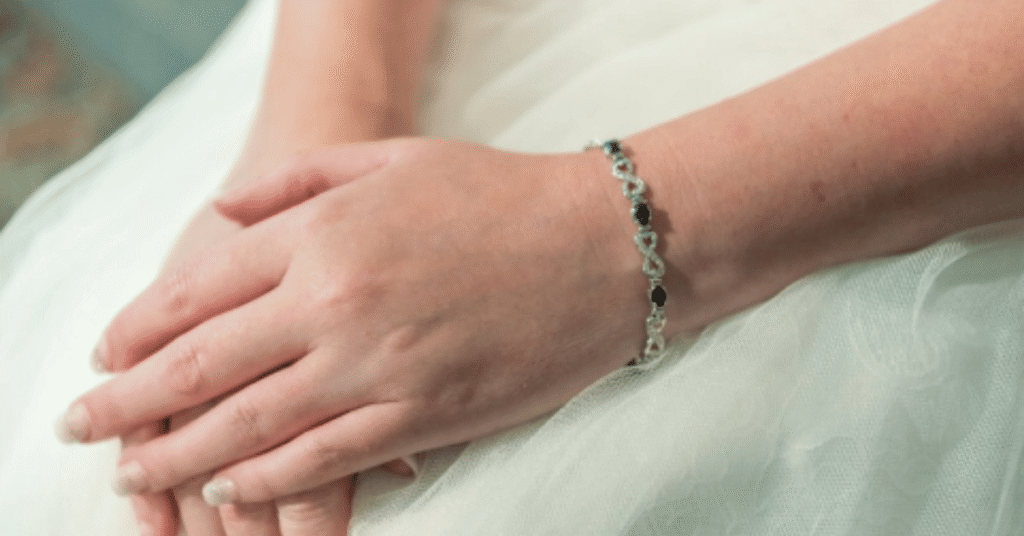Gemmed bracelets have captured human imagination for millennia—not just as decorative pieces, but as silent storytellers of status, spirituality, memory, and fashion. At their core, a gemmed bracelet is a band worn around the wrist embedded with gemstones, yet its implications stretch far beyond ornamentation. Whether it’s a diamond tennis bracelet on a red carpet or a birthstone bangle passed down through generations, gemmed bracelets continue to shape how we express identity, emotion, and elegance. For seekers wondering what makes a gemmed bracelet meaningful, valuable, and unique, this guide provides detailed insight into its components, craftsmanship, cultural relevance, and lasting legacy.
The modern world often reduces jewelry to trend cycles, but gemmed bracelets resist ephemerality. They blend artistry with mineralogical heritage, carrying within them ancient lore and 21st-century innovation. For instance, in India, gemmed bangles made of gold and rubies hold religious significance, while in the West, minimalist white gold bracelets embedded with sapphires are a nod to understated sophistication. This article walks through various dimensions of the gemmed bracelet: its materials, historical development, design types, and even psychological impact. It includes two comprehensive tables: one detailing gemstone properties and another mapping design types to occasions and cultures.
Gemmed bracelets also tap into something deeply personal. A charm bracelet with inset gems might narrate the birth of a child, a graduation, or a milestone. Even in high fashion, the bracelet isn’t merely an accessory—it’s a symbol. As Gabrielle “Coco” Chanel once said, “Adornment, what a science! Beauty, what a weapon! Modesty, what elegance!” With that, let us unravel the intricate world of gemmed bracelets—layer by layer, stone by stone.
The Origins and Evolution of Gemmed Bracelets
The earliest known gemmed bracelets date back to Mesopotamia and Ancient Egypt, where both royalty and commoners adorned their wrists with symbolic stones like lapis lazuli, turquoise, and carnelian. These bracelets were not only indicators of wealth but were believed to offer protection and healing. The Greeks and Romans refined the practice, integrating gems like garnets and amethysts, embedding them into coiled metal bands to reflect power and philosophical alignment.
The Renaissance saw a flourishing of gemstone craftsmanship in bracelets, with nobles wearing elaborate wristpieces embedded with rubies, emeralds, and pearls. In contrast, Victorian-era gemmed bracelets often carried sentimental value, including lockets and personalized engravings beneath the stones. This evolution continued into the Art Deco period, where geometric motifs and color-contrast gems like onyx and diamonds took center stage, blending elegance with abstraction.
Modern gemmed bracelets combine history with customization. They now span from mass-market accessories to haute couture. Synthetic gemstones and lab-grown diamonds have democratized access, but handcrafted natural-gem pieces continue to hold timeless appeal. Whether set in minimalist designs or Baroque opulence, the gemmed bracelet persists as a living artifact of design evolution.
Anatomy of a Gemmed Bracelet: Materials and Settings
A gemmed bracelet consists of three core components: the base material, the gemstones, and the setting. Each element affects its aesthetic, durability, and value. The base can be crafted from precious metals like gold, silver, or platinum, or from alternative materials like stainless steel, titanium, and even ceramic. Gemstones—natural, synthetic, or simulated—may range from diamonds and sapphires to unconventional picks like moonstones or opals.
Settings matter deeply in ensuring stone security and design fluidity. Popular settings include bezel (where the gem is encased in a rim), prong (secured with metal claws), and channel (gems lined edge-to-edge in a groove). The setting style not only defines how the bracelet looks but also how it wears over time. A prong setting, for example, offers maximum light exposure and sparkle but may require periodic tightening.
Designers often mix settings to emphasize contrast and elegance. For instance, a tennis bracelet might use prong settings for diamonds, while the same piece incorporates channel-set sapphires at intervals. Whether classic or avant-garde, the setting techniques influence not only aesthetics but practical wearability.
Popular Gemstones Used in Bracelets and Their Properties
| Gemstone | Color Variants | Symbolism | Hardness (Mohs Scale) | Common Uses |
|---|---|---|---|---|
| Diamond | Clear, Pink, Yellow | Purity, Strength, Eternity | 10 | Tennis, Statement |
| Sapphire | Blue, Pink, Yellow | Wisdom, Royalty, Calm | 9 | Cuffs, Bangles |
| Ruby | Deep Red | Passion, Protection, Power | 9 | Luxury, Vintage |
| Emerald | Green | Growth, Fertility, Prosperity | 7.5-8 | Art Deco, Floral |
| Amethyst | Purple | Peace, Sobriety, Intuition | 7 | Boho, Healing |
| Opal | Multicolor/Iridescent | Creativity, Emotional Balance | 5.5-6.5 | Birthstone, Unique |
| Topaz | Blue, Yellow, Pink | Joy, Confidence, Affection | 8 | Everyday, Adjustable |
| Garnet | Red, Orange, Green | Energy, Commitment, Friendship | 6.5-7.5 | Vintage, Stackable |
Style Categories and Design Philosophies
Gemmed bracelets exist across a wide spectrum of design philosophies, from the highly ornate to the elegantly minimalist. Among the most well-known styles is the tennis bracelet—a continuous line of gems that emphasizes uniformity and sparkle. First popularized by tennis player Chris Evert, this style became a favorite for its clean geometry and upscale feel.
Charm bracelets incorporate small gem-set charms, often personalized to represent life events or memories. These are especially popular as gifts and heirlooms. Bangle bracelets, often rigid and circular, feature embedded gems either throughout or as a centerpiece. They are common in South Asian and Middle Eastern traditions, symbolizing marital status and prosperity.
Cuff bracelets allow for larger surface areas and more elaborate gem settings, often combining various types of stones in abstract or nature-inspired motifs. Meanwhile, link bracelets use connected segments or chains with gem inlays, offering flexibility in both comfort and design.
The contemporary era has also embraced asymmetry and mixed materials. Designers now use contrasting gems, dual metals, and even raw stones for bohemian or industrial appeal. “Every gem tells a story,” said designer Paloma Picasso, and the design philosophy of a bracelet often serves as its prologue.
Gemmed Bracelet Styles and Their Cultural or Functional Contexts
| Style | Cultural/Functional Use | Common Gem Types | Ideal Occasions |
|---|---|---|---|
| Tennis Bracelet | Western Fashion, Luxury | Diamonds, Sapphires | Gala, Wedding, Anniversary |
| Bangle Bracelet | South Asian, Middle Eastern | Rubies, Emeralds, Gold | Festival, Wedding, Daily Wear |
| Charm Bracelet | Personalized, Sentimental | Birthstones, Topaz | Birthdays, Milestones |
| Cuff Bracelet | Artistic, Bohemian | Opals, Amethysts | Parties, Creative Gatherings |
| Link Bracelet | Everyday Elegance, Layering | Garnets, Topaz | Office, Evening Out |
| Statement Piece | Fashion Forward, Red Carpet | Mixed Gems, Pearls | Awards, Fashion Events |
Personalization and Symbolism in Gemmed Bracelets
Modern consumers increasingly seek customization in their jewelry. Gemmed bracelets have responded with made-to-order offerings that allow buyers to select their own gemstones, metal type, and engraving. Birthstones are especially popular, with people choosing specific gems aligned with birth months, zodiac signs, or life events. Some opt for engraved initials or coordinates beneath the stones for hidden meaning.
Symbolism also drives many choices. For example, pairing sapphire and emerald may represent peace and prosperity, while garnet and topaz might symbolize loyalty and emotional healing. Multigenerational gifting of bracelets—with each generation adding a new gem—has also become a symbolic tradition in many families.
These emotional layers elevate the bracelet from adornment to heirloom. “Jewelry is a way of keeping memories alive,” said designer Carolina Herrera. This is especially true with gemmed bracelets, which often accompany rites of passage, achievements, or acts of love.
Craftsmanship and Ethical Considerations
True value in gemmed bracelets is often hidden beneath the surface—in the craftsmanship. Artisans spend hours cutting, polishing, setting, and assembling every part. Precision in gem placement ensures symmetry, while soldering and polishing refine the bracelet’s finish. Handcrafted pieces, particularly from master jewelers, reflect superior artistry and command higher prices.
However, ethics are increasingly influencing buyer behavior. Consumers want to know if gems are conflict-free, if the metals are sustainably sourced, and whether labor practices respect artisans’ rights. Many jewelers now offer certifications and transparency reports. Lab-grown gems, which mirror the beauty and properties of natural ones, offer an ethical and often more affordable alternative.
Ethical craftsmanship enhances both emotional and resale value. It assures the buyer that beauty hasn’t come at the cost of exploitation. As the demand for transparency grows, sustainability may become as important as sparkle in the world of gemmed bracelets.
Maintenance, Care, and Longevity
Caring for a gemmed bracelet is essential to preserving its brilliance and structure. Each gemstone has specific sensitivities. Diamonds, while incredibly hard, can still get cloudy if exposed to oils. Softer gems like opals or pearls require more gentle cleaning and storage. Using a soft brush and mild soapy water is safe for most stones, but ultrasonic cleaners should be avoided unless advised by a professional.
Storage matters too. Bracelets should be stored flat and separately to avoid scratches. Padded boxes or fabric pouches are ideal. For frequently worn pieces, periodic professional cleaning and prong-tightening are advisable. Everyday wear pieces may lose polish faster but can be replated or buffed.
Understanding the physical properties of your bracelet not only ensures its longevity but also enhances your appreciation of its construction. A gemmed bracelet that’s well cared for can last decades—sometimes centuries—and be passed down as a treasured legacy.
Conclusion: The Enduring Magic of the Gemmed Bracelet
Gemmed bracelets are not simply wrist adornments; they are miniature universes of history, craftsmanship, emotion, and symbolism. From ancient rituals to modern fashion, from ruby-studded bangles in Indian weddings to diamond tennis bracelets worn at global galas, these accessories serve as deeply personal artifacts and cross-cultural emblems. Each stone, each setting, and each curve of metal reflects intentional design, legacy, and human creativity.
Their appeal is not only in their sparkle but in their substance. They tell stories of celebration, remembrance, and identity. Whether ethically crafted with lab-grown gems or curated with heirloom diamonds, gemmed bracelets offer more than beauty—they offer meaning. As jewelry historian Vivienne Becker once said, “Jewelry is the most personal thing a woman can wear; it tells you who she is.” That sentiment extends universally across time, gender, and geography.
In an age of fast fashion and digital overload, the enduring presence of the gemmed bracelet reminds us to cherish things that take time, tell stories, and sparkle with integrity. It is a piece of the earth—and of the soul—carried on the wrist, every day.
FAQs
1. What is a gemmed bracelet?
A gemmed bracelet is a wrist ornament embedded with gemstones like diamonds, rubies, or sapphires for style and symbolism.
2. Are gemmed bracelets suitable for daily wear?
Yes, but durability depends on the gemstone and setting—diamonds and sapphires are better for daily use than opals or pearls.
3. Can I customize a gemmed bracelet with birthstones?
Absolutely. Many jewelers offer personalized gem choices, including birthstones, initials, and symbolic engraving for a unique touch.
4. What is the difference between natural and lab-grown gemstones?
Natural gemstones are mined from the earth, while lab-grown gems are chemically identical but created in controlled environments.
5. How should I care for my gemmed bracelet?
Clean gently with mild soap and a soft brush, store it separately in padded containers, and avoid harsh chemicals or impacts.







